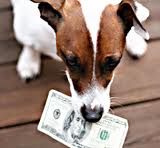These last three weeks in my life have been some of the toughest I’ve gone through in a while. About three weeks ago I started coming down with flu-like symptoms. Two days after that the symptoms developed into laryngitis and I completely lost my voice. Along with that I had a sore throat, headaches, nausea, and an overall ‘blah’ feeling.
I say this not to whine, I say it because having several weeks of not being able to talk has taught me a valuable lesson.
Those who know me know that I talk. Some even accuse me of never shutting up. It seems like I’ve always got something on my mind and I’m always telling everybody. In spending weeks without being able to talk, though, I went through some amazingly frustrating times just trying to get my point across.
It reminded me of the predicament that most dogs I meet are currently going through. Most dogs I meet are desperately trying to communicate with their owners. They are telling their owners what they want through their behavior. Their actions might be telling their owners that they need more structure, more exercise, more attention. Their behavior may be saying that they want leadership, they want training, and they want boundaries.
They are communicating all of these needs in the only way they know how. Sadly, most owners have no clue what their dogs are trying to tell them and, as a result, give them only a tiny portion of what they really need in order to be happy, well-adjusted, and well behaved.
What most people describe as bad behavior from their dogs is really a failure to communicate and understand one another.
Here is the thing, though. When it comes to dogs, they are never going to learn our language. It’s up to us as dog owners to learn how dogs think, speak, react, behave, etc. and how to use that understanding to help our dogs be the best trained dogs possible.





Follow Us!